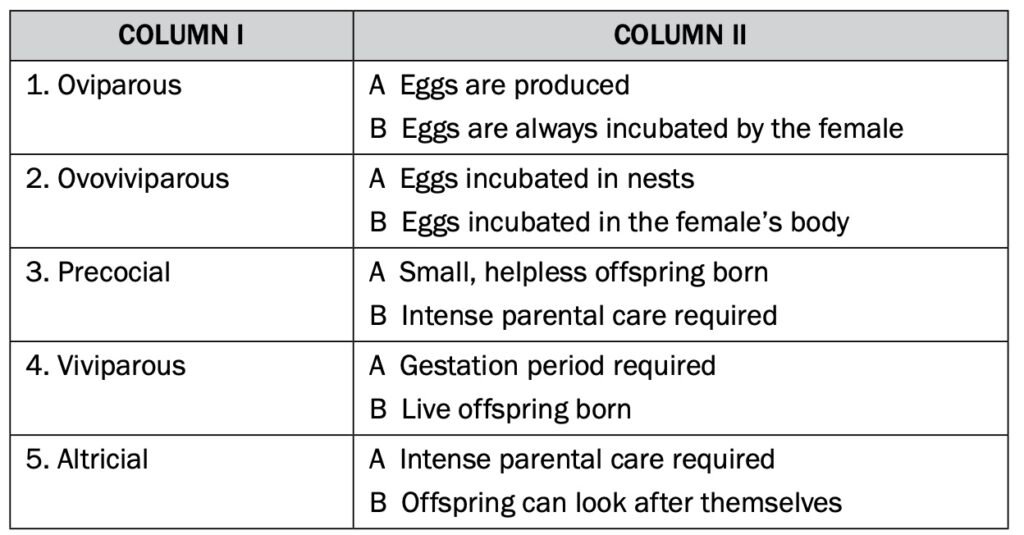JOIN OUR WHATSAPP GROUP. CLICK HERE
Reproduction in Vertebrates Diversity of Reproductive Strategies
Reproduction in Vertebrates Diversity of Reproductive Strategies Vertebrate reproduction Various Reproductive Techniques
In order to maximize reproductive success in various circumstances, several animal groups have developed diverse reproductive techniques. These are only a handful of the tactics that vertebrates employ.
Reproduction in Vertebrates Video Lesson
Reproductive Strategies
Below are the different reproductive strategies of vertebrates animals in a table format, how it works, as well as the advantage of each:
| Strategy | How it works? | What is its advantage? |
|---|---|---|
| External Fertilisation | The sperm fertilises the egg outside the body of the female, usually in water. | Water prevents the eggs from drying out and allows the sperm to swim towards the egg. |
| Internal Fertilisation | The male deposits its sperm inside the reproductive organs of the female and fertilisation occurs inside the female’s reproductive organs. |
Allows terrestrial animals to reproduce in a dry environment without the need for water. Internal fertilisation is more certain than external fertilisation. |
| Ovipary | Eggs are laid and hatching takes place outside the mother’s body. | Egg provides nutrition for the developing embryo and protects the embryo. A shelled egg frees these animals from the need to reproduce in water. |
| Vivipary | The young develop inside the uterus of the mother after the eggs are fertilised internally. | More efficient development of the embryo as nutrients are received for a longer period from the mother’s blood through a placenta. Embryo is protected in the body of the mother. |
| Ovovivipary | oung develop from eggs that are fertilised internally and retained within the mother’s body after fertilisation until they hatch. | Embryos obtain their nutrients from the egg yolk. The eggs are protected from predators until hatching occurs. |
| Amniote Egg | Embryo protected by the shell of the egg; egg consists of many extraembryonic membranes that serve different functions. | Amniote egg protects embryo from dehydration. Yolk sac provides nutrition, Allantois for excretion, chorion for gas exchange. |
| Precocial Development | Hatchlings are quite well-developed when they hatch – eyes open, able to move, able to feed. Brain size and intelligence remains the same throughout their lives. | Hatchlings are more prepared to handle the challenges of the environment; More independent. |
| Altricial Development | Hatchlings are poorly-developed when they hatch. Unable to feed on their own, cannot move. Brain size and intelligence increases a lot after hatching. | Parental care afforded to protect the young from predators. |
| Parental Care | Parental care offered through building of nests, protecting the eggs, protecting the young, teaching the young. | Increases chances of survival of the young. |
Reproduction in vertebrates Questions and Answers Activity
Look at the table below and answer the following questions:
Question
Indicate whether each of the statements in COLUMN I applies to A ONLY, B ONLY, BOTH A and B or NONE of the items in COLUMN II. Write A only, B only, both A and B, or none next to the question number (1 to 5).

Answers
- A only (B is wrong, because some animals, like insects, simply lay their eggs and do not incubate them. In some birds both the male and female incubate the eggs)
- B only (A is wrong, because the eggs are not released from the female’s body)
- None (Precocial animals are born quite well-developed, they can live independently from their parents and find their own food, so parental care is not required)
- Both A and B
- A only (B is wrong, because altricial animals are born small and helpless. They cannot look after themselves or find their own food. Their parents must look after them, protect them and feed them.
JOIN OUR TELEGRAM CHANNEL. CLICK HERE

Be the first to comment